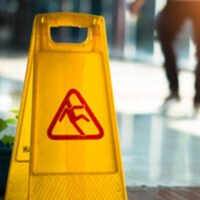California Court Upholds $329,000 Slip-and-Fall Verdict Against Rite-Aid

In California, a business can be held liable for slip and fall accidents caused by a dangerous condition on the premises. To be clear, a business is not automatically responsible for every accident that may occur. Rather, the law requires proof that the business owner had “actual or constructive” notice of the dangerous condition and failed to take reasonable steps to remedy it prior to the accident.
Court Chides Defense for Failing to Preserve Surveillance Video Evidence
In simple terms, constructive notice means that the dangerous condition existed for a sufficient length of time that a business owner exercising reasonable care should have identified the problem. A slip-and-fall victim can prove constructive notice through circumstantial evidence alone. For example, if there is proof that the management failed to conduct routine inspections of public areas for hazards, that can demonstrate a lack of reasonable care.
A recent decision from the California Second District Court of Appeal, Aposaga v. Rite Aid Corporation, provides a helpful illustration. This case involved a 77-year-old plaintiff who sustained multiple leg fractures after a slip-and-fall at a drugstore. She sued the drugstore, alleging a slippery substance on the floor caused the fall. At trial, the plaintiff testified she saw what appeared to be oil on the floor while she was lying on the ground after her fall. It was not clear how long the oil had been present prior to the accident, but a drugstore manager testified that she conducted a “walk-through” of the area about 15 to 20 minutes beforehand.
A jury found the drugstore liable and awarded the plaintiff approximately $329,000 in damages. On appeal, the drugstore argued that there was insufficient evidence that there was ever a slippery substance on the floor or, if there was, that ownership had “constructive notice” of the problem. The Second District disagreed and affirmed the jury’s verdict. The appellate court noted that the jury was entitled to believe the plaintiff’s testimony as to the existence of the oil on the floor. And there was sufficient circumstantial evidence from the manager’s testimony to establish enough time passed between the manager’s last inspection and the plaintiff’s accident to provide constructive notice of the oil spill.
The Second District also dismissed the drugstore’s objection to the trial judge’s instruction to the jury regarding the destruction of evidence. At the start of the lawsuit, the plaintiff’s attorney sent a letter asking the store to preserve any evidence relevant to the case. This included surveillance video footage of the store. But the store ignored this request and failed to preserve any video from the day of the plaintiff’s accident. The judge instructed the jury it could consider whether this was an intentional destruction of evidence, and if so, draw an unfavorable inference against the defense. The Second District said the instruction was appropriate.
Contact a Palmdale Slip and Fall Accident Attorney Today
Slip and fall accidents often involve complicated legal questions like the ones discussed above. That is why it is important to work with an experienced Palmdale slip and fall lawyer following any serious accident. Contact the Trevino Law Firm today to schedule a free consultation. We serve clients in Palmdale, Lancaster, Littlerock, and Lake Los Angeles.
Source:
scholar.google.com/scholar_case?case=14004409391453024169
